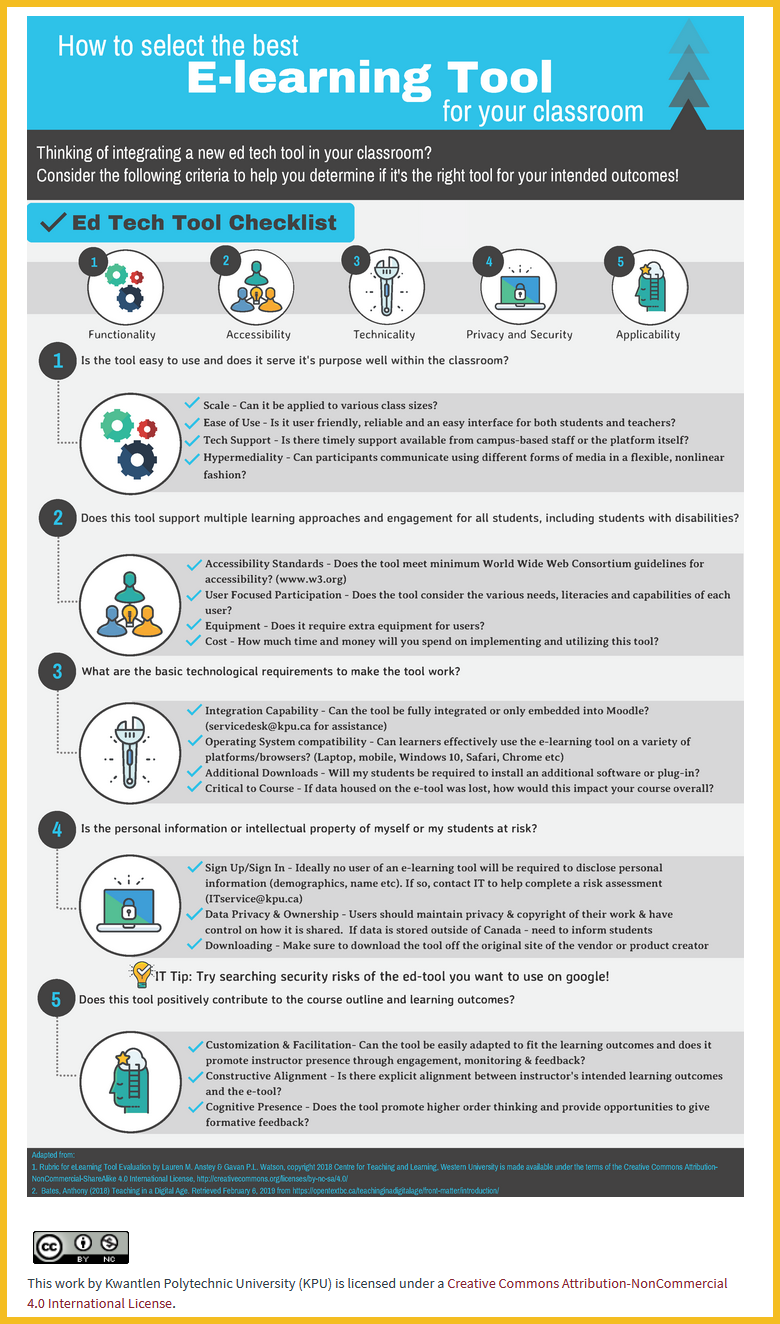Considerations when Choosing Technology for Teaching
Content Menu
- Meaning
- Models
- Infograph
- References
1. Technology in learning can mean two things:
- the tools you can be using, such as the hardware, software, networks, web applications
- the processes, such as the methods and strategies you can use for your instruction, the assessment and tracking of student learning, and the design of learning management systems
2. Models Guiding Technology Selection
In times when digital and physical worlds are more intertwined, decision-making for digital technology becomes an ever more complex endeavour owing to the broad range of interacting variables which need to be considered to make fully informed choices. The following models are frameworks specifically designed for educators as guides in their selection of educational technology for teaching and learning.
A The TPACK Model
In the definition of the term, its founders (Mishra and Koehler, 2006) emphasize the individuality of teaching and the unique contexts we all act within, which will have to inform our technology integration in similarly individual way. On his TPACK website Koehler asks, ” […] how can teachers integrate technology into their teaching? An approach is needed that treats teaching as an interaction between what teachers know and how they apply what they know in the unique circumstances or contexts within their classrooms.” (Koehler, 2009)

TPACK is the complex interplay of three primary forms of knowledge: Content (CK), Pedagogy (PK), and Technology (TK). The TPACK approach goes beyond seeing these three knowledge bases in isolation. The TPACK framework goes further by emphasizing the kinds of knowledge that lie at the intersections between three primary forms: Pedagogical Content Knowledge (PCK), Technological Content Knowledge (TCK), Technological Pedagogical Knowledge (TPK), and Technological Pedagogical Content Knowledge (TPACK).
Effective technology integration for pedagogy around specific subject matter requires developing sensitivity to the dynamic, transactional relationship between these components of knowledge situated in unique contexts. Individual teachers, grade-level, school-specific factors, demographics, culture, and other factors ensure that every situation is unique, and no single combination of content, technology, and pedagogy will apply for every teacher, every course, or every view of teaching. (Koehler, 2012)
B The SAMR Model
Unlike TPACK, which highlights the interrelation between technology, pedagogy and content, the SAMR model aims to describe degrees to which technology integration can happen in teaching by establishing what the effects are. Technology integration is viewed as a spectrum with one-on-one replacements for “traditional” tools/ methods on the one end and with tools enabling the complete transformation of teaching on the other. The visual below depicts the four different stages in the model, which you can discern by asking yourself the following question:
In how far does the integration of technology alter tasks and teaching?

(L. H., 2017)
C The SECTIONS Model
The SECTIONS model (1, 2) is a widely applied framework for many educators in Higher Education. To teach effectively with technology, it is recommended that you start your planning with a definition of the learning goals you would want your students to reach by the end of a specific section in your course. This sequencing of your course planning enables you to conduct an effective assessment of the potential technological tools that you could employ to help your students reach those goals. You will then arrive at a decision that is pedagogically sound that considers the ease of use of the tool for you and your students, the costs involved, and the support you will require for your implementation. Each of the letters in the acronym SECTIONS stands for a uniqe aspect worth your consideration while you are evaluating a specific tool for teaching.
3. At a glance
 You can download the infograph in pdf format here: Ed Tech Tool Checklist Infographic
You can download the infograph in pdf format here: Ed Tech Tool Checklist Infographic
4. References:
Bates, T. Chapter 8: Choosing and using media in education: the SECTIONS model. In: Teaching in a Digital Age [Internet]. Tony Bates Associates Ltd; 2015 . Available from: https://opentextbc.ca/teachinginadigitalage/part/9-pedagogical-differences-between-media/
Bates, A. W. and Poole, G. Effective Teaching with Technology in Higher Education. Jossey-Bass: San Francisco, 2004.
Brinkley-Etzkorn KE. Learning to teach online: Measuring the influence of faculty development training on teaching effectiveness through a TPACK lens. The Internet and Higher Education. 2018 Jul 1;38:28–35.
Contact North. (2018). 10 Guiding Principles for the Use of Technology in Learning. Retrieved from https://teachonline.ca/sites/default/files/toolstrends/downloads/10_guiding_principles_for_use_of_technology_in_learning.pdf
Koehler, M. J., & Mishra, P. (2009). What is technological pedagogical content knowledge? Contemporary Issues in Technology and Teacher Education, 9(1), 60-70. Retrieved from https://www.learntechlib.org/p/29544/
L. H. SAMR Model: A Practical Guide for EdTech Integration [Internet]. 2017 [cited 2020 Sep 25]. Available from: https://www.schoology.com/blog/samr-model-practical-guide-edtech-integration
Mishra, P., & Koehler, M. J. (2006). Technological pedagogical content knowledge: A framework for integrating technology in teacher knowledge. Teachers College Record, 108(6), 1017-1054. Retrieved from http://onlinelearningcurriculumcommittee.pbworks.com/f/mishra.pdf


